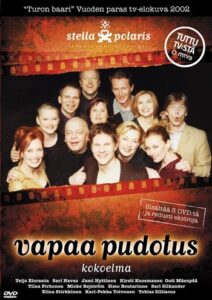MEMORABLE MOMENTS (round 3)
LET THEM ALL TALK – Meryl Streep, Diane Weist, Candace Bergen, Steven Soderbergh

Directed by Steven Soderberg, LET THEM ALL TALK was shot in 10 days while crossing the Atlantic on the Queen Mary 2 surrounded by 2600 passengers and virtually no film equipment.
It was quick. It was cheap. And, it was improvised. The performers were handed the end moments of a scene and simply told to “get there”.
The big names of the movie, Meryl Streep, Candice Bergen, and Dianne Wiest have a combined ONE HUNDRED AND SIXTY THREE YEARS of performance experience (as of 2022), and none of them had ever made an improvised movie before this. ( Meryl Streep – 47 years in the industry, Candice Bergen – 64 years, and Dianne Wiest -52 years). The rest of the cast held their own in this improvisation experiment.
Steven Soderbergh, working off of an outline of a screenplay by Deborah Eisenberg, directed, edited, and shot the film while rolling around in a wheelchair and relying on existing lighting on the cruise ship.
Shooting the story in chronological order (also rarely done in film), Soderbergh took it upon himself to edit the improvised moments every evening into what would become a cohesive 2-hour movie.
When asked if Soderbergh ever said “NO, that won’t work – Do it again” with any of the improvisation, Meryl Streep said he accepted everything. “It’s all in the editing Babe!”
Streep must have really wanted to be in the project. She was only paid TWENTY-FIVE CENTS for her work and seems to have had a great time noting:
“IT WAS A KICK! BUT IT WAS TERRIFYING“
I told [Soderbergh] he was gonna ruin everything for every director, and every production designer, and everything else, because he made the movie for 25 cents — I know that’s what I was paid. Then it was made in two weeks, and it was a free ride on the boat.
In the process, Streep says, “Each day had the outlines of an idea but we had no script. We’d go to bed every night worried that we wouldn’t come up with anything interesting.”
Dianne Weist was quoted as saying something that all improvisers should remember concerning the terror she felt performing on the tightrope of uncertainty,
” It was absolutely terrifying. But everything was so heightened, and when Steven said, “GO,” you could forget about the terror, because you really had to pay attention to what was going on if you were gonna make any sense at all. If you didn’t pay attention, then you should keep your mouth shut.”
They wore their own clothes from their own suitcases. When they ate their breakfast, they shot a breakfast scene. Life and art were rarely separate.
 Over the years I’ve worked with the Improvisers, STELLA POLARIS from Finland. Ahead of their time when it came to Film Impro, Stella Polaris created a 10 episode improvised narrative television series (Vapaa pudotus – 2002) as well as an improvised movie. (Kukkia & sidontaa – 2004)
Over the years I’ve worked with the Improvisers, STELLA POLARIS from Finland. Ahead of their time when it came to Film Impro, Stella Polaris created a 10 episode improvised narrative television series (Vapaa pudotus – 2002) as well as an improvised movie. (Kukkia & sidontaa – 2004)
Their process of researching the occupations of their characters (Butcher, Florist, etc) was similar to Candice Bergen’s approach in Let Them All Talk. They knew they would play with certain occupations, so they explored them before improvising. The result is content that is relevant to the characters and grounded in experience for the actors. .
Reflecting on her preparation Bergen says, “her (character’s) father was an oil rigger, so I went to Texas and I saw an oil rig, because, of course, I was working with these guys, so I thought, “I better prepare as much as I can.”
Along with general concepts for preparation the actors had some help from writer, Deborah Eisenberg who was on board the cruise. When Meryl Streep’s character has to give a lecture (to actual guests on the cruise) about a writer from another century, Eisenberg created a cheat sheet of ideas to pull from and play with. Sort of a “Lines of Dialogue” scene where random bits of script inspire the dialogue.
In their words, the improvisation “spoiled” the actors who all remarked that going back to the limitations of traditional scripted movie making was going to be a challenge.
Weist reflected that “it’s wonderful because instead of thinking of your next line, you really have to respond, you really have to listen…”
Talking to the writer of an unrelated project she said she was reluctant to fall back into the scripted work but then “…realized after that was out of my mouth, I just axed her job. I felt badly.”
THE REVIEWS ARE IN… sort of.
We shouldn’t use the phrase “IT IS IMPROVISED” as an excuse for the work or as a request for an audience to go easy on the Content. Does the story stand on its own feet or are we relying on the process of improvisation to sell our work? Does the content engage our audience?
LET THEM ALL TALK is an interesting impro experience. And, not only interesting in the fact that it’s improvised. It’s interesting with how it has been received and reviewed.
It’s fascinating how much the process is focused on before the content is considered. “It’s amazing that they didn’t have a script” is a commons phrase but you rarely hear, “The story was amazing. Oh… and it was improvised.
And who trust reviews?
Of course, take reviews with a grain of salt, BUT, consider listening when a varied group of people gives similar feedback. It tells you where you have universal appeal or failure. We shouldn’t pander for acceptance but don’t ignore what the world says about you. Like it or not, large numbers of “average people” can give a more honest perspective than those with a vested interest in looking “intelligent”.
Rotten Tomatoes deceptively gives a rating of 87% from ‘professional’ reviewers which seems …positive. But then there’s a lower rating of 50% that comes from an actual audience with no vested interest in the movie or the reviewing experience except to ask themselves, “WAS IT WORTH MY TIME/MONEY TO WATCH WHAT I JUST WATCHED?” This is not a “Whose Line is it Anyways” audience who comes for the impro. They’re there for a movie with a solid story.
That review of 50% tends to reflect a value closer to what I felt. (I’d give it a 60%). The 87% value from the professional reviewers felt more like insiders adding on a few more percent because of the process rather than the content itself.
Don’t get me wrong. There’s a lot I like in the film. I thought Soderbergh did a great job of editing the improvisation into a fairly clean arc of plots and sub-plots. I enjoyed watching the performers out of their comfort zone, improvising. They could have worked on the ending and maybe being altered by each other a little more.
But…
I realised that I was in my head a lot of the time. The movie, the characters, and the story didn’t give me a gut reaction. It left me looking at the magician’s technique versus being engulfed by the magic itself.
Discomfort with improvisation can make performers negative, hesitant, heady, and disconnected. I felt that was happening here.
I remember thinking at one point that I knew some of the improvisers in the movie. Of course I didn’t know them personally but the style that many of them embraced felt self conscious like improvisers I’ve seen “trying” a little too hard to create “meaningful” work. A little self-important and contrived and in their heads.
I thought Gemma Chan stood out because she was “different”. Where most of the characters adopted a hesitant serious presentation in a Woody Allen, self-concerned style, Chan was fluid and embodied her character with a stability that others sometimes missed.
Candice Bergen had stand-out moments as well.
Of course, all of the performers had their moments but like any improvisation work, there were many moments that came more from the head than the gut.
When the film had me focusing on technique rather than engaged in story, I knew the magic wasn’t there for me.
Maybe it was just me and my improviser brain looking for the strings being pulled. I’d suggest you check it out for yourself, if for no other reason than to see another style of improvisation in the mainstream.
One reviewer of LET THEM ALL TALK, says:
A clever and absorbing film that feels, alas, a little unfinished and a touch too improvisational.
and a note that could have been spoken after an improvised stage show that I recently saw presented by self-congratulatory improvisers:
The premise is solid, the cast is beyond reproach and yet this is an oddly unengaging affair. The story moves along steadily but with a surprising lack of urgency or energy.
We shouldn’t use the phrase “IT IS IMPROVISED” as an excuse for the work and we should never call garbage gold because we made it up on the spot. Does the story stand on its own feet? Are we relying on the process of improvisation to sell our work or is the content engaging our audience?
You know what I think. Check it out and see for yourself.




0 Comments